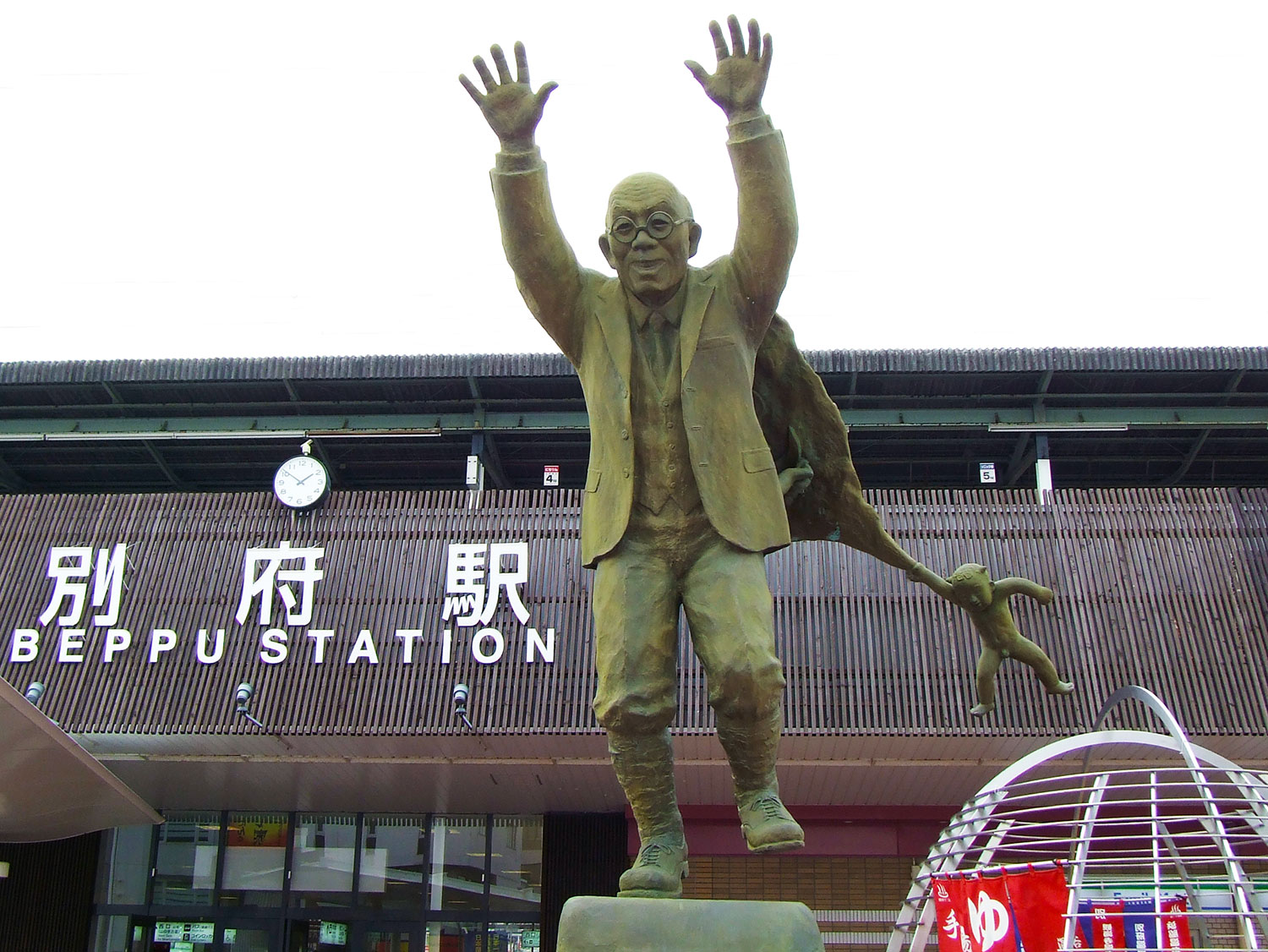
Kumahachi Aburaya
Dignified statues celebrating heroines and heroes, stateswomen and men, and local personages are…

Maybe exploring Oita’s railway heritage by road does seem to be a little non-sensical but please bear with us and read on.
Duration: 4 days beginning in Nakatsu and ending at Oita.
Day 1 Usa - Nakatsu
Head to Kyushu in super-fast style on Japan’s iconic and sleek Shinkansen bullet train. At Kokura, transfer to the pendolino Sonic Express, one of the first of JR Kyushu’s stylishly-designed trains, for Usa, in Oita’s northern reaches. Your road trip begins here.
Visit nearby Usa Jingu. Although one of the most important and impressive national shrines in Japan, it is a quiet oasis and delight to stroll around. Importantly for us, in its grounds is displayed a 18910-vintage Munich-built steam locomotive, which worked the Usa Jingu Line, 8.8km of tracks running between the shrine via Usa Station to Bungo-Takada, from 1948 until 1965, when the line closed.
Nearby is the excellent Oita Prefectural Museum of History, and also the remains of a World War Two airbase and associated Usa Peace museum for a rare look at war-time Japan.
Travel onto Nakatsu to check in at the Kisha Popo, a railway-themed hotel for enthusiasts of all ages. Railway paraphernalia includes a steam engine and carriages, which have been incorporated into the hotel as restaurant and guest rooms. These were saved from the scrap heap by the proprietor’s father when the local Yabakei Line was closed in 1975.
Day 2 Usa - Yabakei - Hita
Set off for Yabakei, a lovely scenic area of valleys. Your road largely follows the original route of the Yabakei Line to Ao-no-Domon, a hand-hewn tunnel aside the Yamakuni River. From here, the last section of the line has been turned into the delightful Maple Yabakei Cycling Road. However, before heading to the cycle terminal to hire your bikes for the day, visit the nearby and spectacularly located Rakan-ji temple.
Jump on your bikes to explore the gently inclined route of the old Yabakei Line for the 22 kilometres (13.7 miles) to its terminus at Morizane Onsen. Lunch here and if you need to, soak in the soothing hot spring waters at Morizane’s Yasuragi-no-Sato Onsen. Cycle the gentle incline back to the terminus at Ao-no-domon and continue your journey by car to Hita.
Make your way to Hita Station, which serves as much more than just a transportation hub. Its warm-wood finished design incorporates a study and library, cafe and accommodation. The latter two overlook the rail tracks and the coming and going of the local single carriage and splendid Yufuin-no-Mori resort trains. The accommodation is clean and simple and perfect for train fanatics. Alternatively, we recommend Ume Hibiki, a gorgeous hot spring hotel beautiful countryside overlooking a gorge. The rail connection, however, is not lost here as it has been created by JR Kyushu.
Day 3 Hita - Oguni - Kusu
Make the most of your time at Ume-Hibiki spending a leisurely morning here before making your way to Oguni Yu Station, across the border in Kagoshima Prefecture. A short section of remaining track hints at the site’s origins as this homely town’s railway station, the terminus of the Miyahara Line, which closed in 1984, to Kokonoe in Oita.
Relax here for lunch before beginning a gently descending five kilometre (3 mile) walk following the route of the old line, via its original bridges and tunnels, through bucolic countryside to Kitazato. Here, make time to visit the picturesque and interesting home, now a small museum and memorial to Shibabsaburo Kitasato, a bacteriologist who was nominated for the first annual Nobel Prize in Physiology or Medicine in 1901.
Followed the road to Bungo-no-Mori in Kusu, and its atmospheric Roundhouse, which was once a depot for steam locomotives. The roundhouse has long been disused but is now one of Oita’s iconic sites. Displayed in front is a splendid 1919-vintage Class 9600 steam locomotive, which were the first engines to be mass-produced in Japan. A quaint museum about the roundhouse and railways is located nearby, and on weekends and public holidays a minature steam railway operates in the grounds to the delight of child and adult passengers alike.
Tonight, stay at Hatago Sakura in nearby Housenji Onsen. There is no obvious connection with trains, but it is a delightfully luxurious and leisurely accommodation for an evening, a place to throughly savour your journey so far.
Day 4 Kusu - Oita City
After being refreshed and satiated by your accommodation’s onsen hot spring baths and sumptuous cuisine, set off for Oita City. The city is at the hub of Oita Prefecture’s train network and your hotel for the evening, the JR Kyushu Oita Blossom sits right above the main station.
First, however, visit Model Railway Sonic, a short drive from Oita Station. The large layout here is a passion project of the owner, and a popular destination of all ages of rail enthusiasts.
Oita Station is a multi-storey complex housing platforms, shopping and entertainment complex. Within is Popondetta, a specialist model railway shop. Besides merchandise from Japan’s top manufacturers it also sports a layout that can be rented out by the half hour by devotees. A minature railway, that will especially please children, loops around the open rooftop area.
Round your day off in the Oita Blossom Hotel, luxuriating its open-air, roof-top hot spring, 80 metres above the coming and goings on the city’s streets and station platforms before going into town to enjoy one of Oita CIty’s many restaurants and evening entertainments.
If you time your journey carefully you could include an experience on one of JR Kyushu’s luxury trains, the Seven Stars and Sweets Train Aru Ressha, before, during or after your road trip.